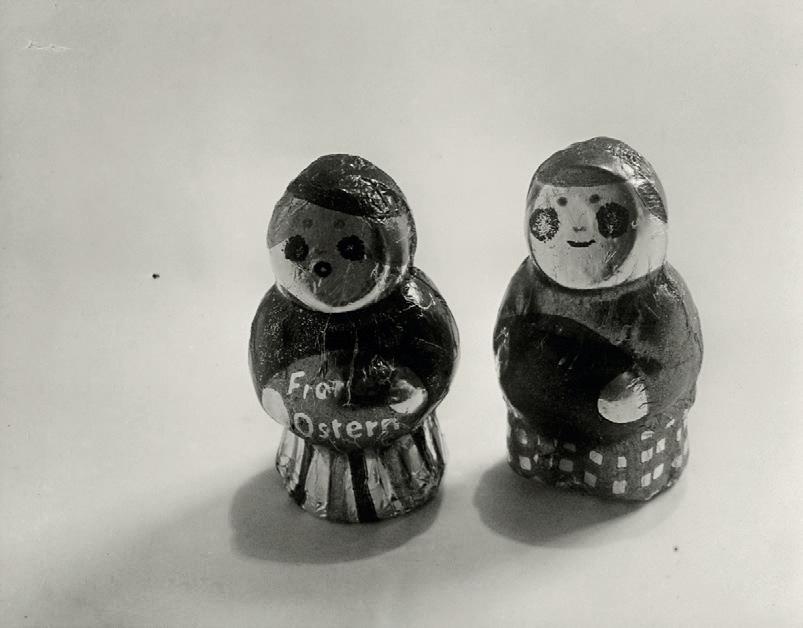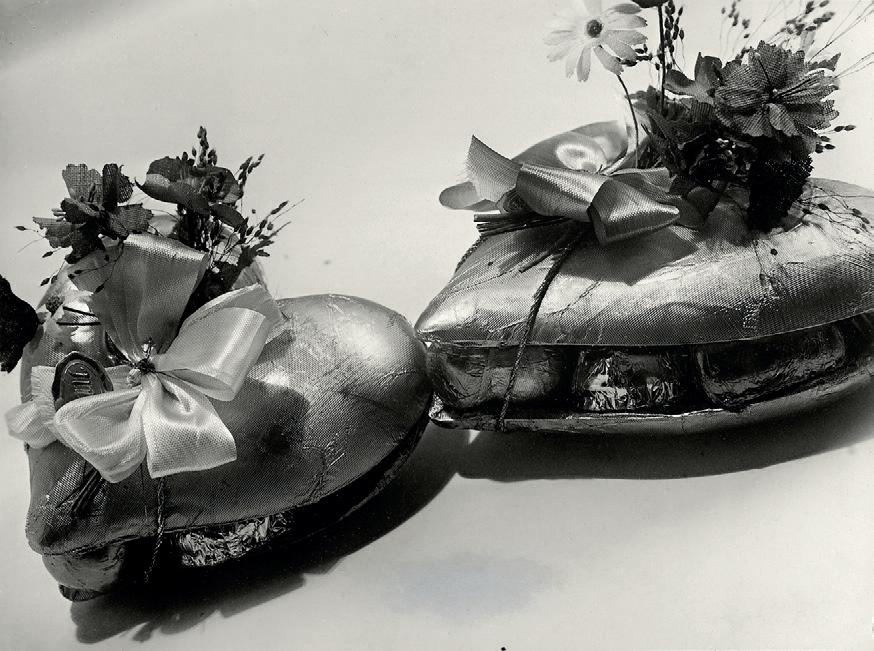Hans Finsler Sweet

too precious to eat.
Phil Rolla
Hans Finsler Sweet
Hans Finsler. Sweet
Rolla.info, Bruzella, Switzerland
14 aprile 2013 - 21 luglio 2013
Mostra e catalogo realizzati da/ Exhibition and catalog supported by Fondazione Rolla
Immagini/Images
Elide Brunati
Traduzioni/Translations
Brendan and Anna Connell
Progetto grafico/Graphic design
Officine Digitali sagl
Stampa/Printing
Novecento Grafico sas
Sostegno/Supported by

© Fondazione Rolla www.rolla.info
Il catalogo è stato realizzato in occasione di Hans Finsler. Sweet, sesta mostra ospitata nell’ex scuola d’infanzia di Bruzella, sede della Fondazione Rolla. Le opere appartengono alla collezione privata di Rosella e Philip Rolla.
Con la mostra Sweet si presenta uno dei lavori iniziali del padre della fotografia oggettiva, la Sachfotografie, Hans Finsler (Heilbronn 1891 - Zurigo 1972). Per trent’anni docente alla Kunstgewerbeschule di Zurigo, oggi Zürcher Hochschule der Künste, ha formato gran parte dei massimi esponenti della fotografia svizzera, da Werner Bischof a René Burri, da Emil Schulltess a Peter W. Häberlin.
Finsler ha dato grande impulso, in connessione con grafici ed architetti di orientamento modernista, ad un’immagine rinnovata dell’industria svizzera, contribuendo sensibilmente a costruire il patrimonio e l’immagine dello swiss made.
Autore in parte misconosciuto, l’esposizione alla Fondazione Rolla ha come centro focale un lavoro giovanile su commissione, dove Finsler mette a punto i caratteri della fotografia, in seguito trasmessi a più di una generazione di allievi, nonché la trasformazione, attraverso la dimensione dello still life, dell’oggetto rappresentato a pura forma dalla dignità estetica ed artistica.
L’intima dolcezza della modernità di Gian Franco Ragno
Disciplinate forme di cioccolato, ordinati eserciti di dolciumi in miniatura, processioni di animaletti avvolti nella carta stagnola, mestieri evocati nelle forme e negli strumenti ed infine, all’interno di questo gioco di richiami, le composizioni di marzapane come vertice di un lavoro compositivo giocato tra forma e finzione, l’apparenza non corrisponde alla materia della forma.
Queste le immagini che compongono Sweet alla Fondazione Rolla, trentacinque piccole prove del giovane Hans Finsler – fotografo di origine svizzera e di formazione tedesca, una delle figure più importanti della fotografia industriale europea. Datate 1928, sono testimonianze inedite di un interessante episodio formativo del protagonista, già maturo intellettualmente, ma ai primi passi con la tecnica di ripresa. In ogni caso, il neo-fotografo forte di una formazione universitaria di primissimo livello in ambito storico-artistico e architettonico – a Stoccarda ed a Monaco di Baviera assiste alle lezioni di Heinrich Wölfllin. Quell’anno Finsler è a Halle, dove docente e bibliotecario della scuola di arte applicate, preme per dare un nuovo impulso in senso moderno alla produzione artistica ed industriale, al pari di ciò che succedeva al più noto Bauhaus dal 1925 a Dessau, dopo i primi anni a Weimar.
Seppure si tratti di prove a contatto, iniziamo ad intravvedere i singoli elementi del sobrio linguaggio artistico di Finsler, la costruzione di un vocabolario utilizzato nel corso della sua lunga carriera: la ricerca nell’oggetto di quelle forme pure, senza ornamento, capaci di dare il ritmo all’opera.
Prima di ogni cosa, nella composizione viene messa al bando qualsiasi traccia di elementi decorativi: gli oggetti sono appoggiati su un piano trasparente, bianco e riflettente, secondo un ordine geometrico e ripresi perlopiù dall’alto. Anche quando l’elemento sconfina il margine dell’immagine, è l’intelletto, come da lezione modernista di Mondrian, a completarne il senso, proprio perché ci troviamo nel perimetro della rappresentazione artistica. In uno spazio dove, usando una chiave di lettura fornita dallo stesso Finsler, gli oggetti appaiono – in una realtà ipotetica – schwerlos, ovvero privi di peso, senza gravità.
Lo strumento principe del fotografo è la luce, e segnatamente quella artificiale. A questo fondamentale, Finsler dedicherà sin da inizio carriera molte riflessioni, studi e sperimentazioni. La luce artificiale cambia i termini in gioco, cambia l’attenzione verso l’oggetto – in breve, ne rivede le sue stesse possibilità conoscitive attraverso il mezzo foto-
grafico. Se in precedenza spazio e tempo combattevano per la costituzione dell’immagine, ora, con la luce artificiale, essi si sommano, dando all’oggetto una fisionomia rinnovata. Nella dimensione pura così costituitasi, si avvia il dialogo silenzioso e rispettoso con l’oggetto, più conoscitivo che compositivo: un’atmosfera di calma e chiarezza, come suggerisce Finsler (Klarheit und Ruhe). Ma il punto più importante è nel dettaglio – il vero specifico fotografico, dove si concentrano le possibilità espressive del fotografo. Parallelamente alle ricerche al di là dell’Atlantico, della Straight Photography, è qui che la fotografia mostra il suo distacco definitivo con la pittura e permette di raggiungere l’essenza stessa dell’oggetto rappresentato. Connesso al dettaglio, vi è la somma di essi, il ritmo della trama.
Negli anni seguenti, Finsler sarà al centro di un momento storico, per molti aspetti, rivoluzionario per la concezione della fotografia. Coinvolto come autore ma anche come organizzatore di esposizioni, alcune delle quali determinanti per il destino della disciplina: ricordiamo solo Foto-Auge nel 1929 (nel catalogo una sua immagine si accosta ad un fotomontaggio di Moholy-Nagy) e la coeva Film und Foto, esposizione itinerante su scala mondiale e momento centrale della diffusione del verbo modernista, esposizione nella quale si incontrarono per la prima volta le ricerche d’avanguardia di tutto il mondo. In questo senso, va interpretata l’inclusione di Finsler nel vasto movimento della Neue Sachlichkeit (Nuova Oggettività) che raggruppa autori assai eterogenei quali August Sander, Albert RengerPatzsch ed anche Ruth Hallensleben, ben rappresentata dalla Fondazione Rolla.
L’anno del suo arrivo in Svizzera è il 1932: il compito affidatogli alla Kunstgewerbeschule di Zurigo, sarà quello di offrire ai nuovi fotografi una visione, ed una formazione moderna ai nuovi operatori visivi, capaci di soddisfare le esigenze di una nuova immagine dell’industria. Ciò avvenne con la costituzione di un corso triennale specializzato, denominato Fachklasse für Fotografie (corso specializzato per la fotografia). Qui, per venticinque anni, si costruiranno – letteralmente – i maggiori autori svizzeri del campo, in grado di proporre e sostenere l’immagine di un paese divenuto moderno, oppure, come fecero in molti, di prendere la strada del reportage e del cinema. Negli anni di insegnamento Finsler continuò a mantenere il suo studio professionale, accettando le sfide della fotografia industriale: le trasparenze dei tessuti, i riflessi delle ceramiche, la fluidità delle sostanze.
Nel 1967, Henri Cartier Bresson lo ritrae nel suo ufficio
per il numero monografico di Du dedicato alla Svizzera: si intravvede un uomo elegante di pensiero, come traspare dai suoi scritti – capace di citare in un giro di senso studiosi ottocenteschi come Bachofen accanto a Marcel Duchamp. Al tempo stesso, però, è un personaggio schivo e poco presente sulla scena artistica – espone raramente dopo il fervore giovanile – tuttavia estremamente attento agli sviluppi e connessioni della fotografia con gli altri campi come l’architettura, le arti applicate e segnatamente con la grafica; ricordiamo ad esempio le sue collaborazioni con Josef Müller-Brockmann. Non vi è qui lo spazio per indagare il suo insegnamento, improntato su una sobria stilistica ed un controllo severo delle forme; sulla grammatica della forma nonché sugli immancabili esercizi formali sull’illuminazione delle uova (ispirandosi in questo caso forse a Brancusi). Certo è, che la sicurezza formale e tecnica che trasmise, furono la base di straordinari percorsi artistici. Pensiamo a colui che fu il più noto tra i suoi allievi, Werner Bischof. Per molto tempo si esercitò sul tema della spirale (conchiglie, il riccio del violino, i riflessi di un ramo nell’acqua) per poi aprirsi al mondo con la fotografia di reportage ma pur sempre memore della lezione finsleriana sul dominio della luce. Certo non furono le immagini di Finsler – perlopiù oggetti, interni e qualche raro paesaggio – a colpire Edward Steichen, allora direttore del dipartimento di fotografia al MoMA di New York al suo arrivo a Zurigo nel 1952 (un documentario di René Burri, altro allievo di Finsler, ne racconta l’evento). Nella ricerca del fotografo americano di immagini per la più grande esposizione di fotografia della storia, The Family of Man, dove si celebrava la fotografia di reportage e la figura umana, le scelte furono certamente altre.
Tuttavia, considerata con una maggiore prospettiva storica e culturale, la fotografia oggettiva di Finsler resta tra i migliori viatici per sondare il nostro tempo: ne rivela apertamente le utopie e le contraddizioni – interpretandone le aspirazioni, tra cui il progresso tecnico ed il valore democratizzante dell’oggetto industriale: testimonianze visive senza le quali non potremmo, ad oggi, cercare di capire le trame, in questo caso del pensiero, tra passato e futuro.
Hans Finsler
Nato in Germania da una famiglia di origine svizzera, Hans Finsler (Heilbronn 1891 - Zurigo 1972), dopo gli studi in Architettura e Storia dell’Arte a Stoccarda e Monaco di Baviera, diventa docente presso la scuola di arti applicate di Halle. Partecipa alle principali avanguardie artistiche del periodo della Repubblica di Weimar, trasferendosi nel 1932 a Zurigo, dove si divide tra insegnamento alla scuola di arti applicate (Kunstgewerbeschule) e attività professionale. Alle sue lezioni si sono formati i maggiori fotografi svizzeri del dopoguerra: Werner Bischof, René Burri, Peter W. Häberlin, Ernst Scheidegger, Emil Schulthess ed Anita Niesz.
Nel 2006, un’importante esposizione monografica al Museum für Gestaltung di Zurigo, ha sottolineato il suo fondamentale ruolo nella costruzione della cultura visiva svizzera.



































Schokoladenfabrik Most, 1928
Stampe a contatto vintage/vintage contact prints, 8.4 × 11 cm - 9 × 11.8 cm ca
35 fotografie/photographs
This catalog was realized on the occasion of Sweet, the sixth exhibition held in the ex-kindergarten of Bruzella, home of the Rolla Foundation. The photographs are from the private collection of Rosella and Philip Rolla.
Sweet shows one of the initial works of the father of objective photography, the Sachfotografie, Hans Finsler, (Heilbronn 1891 - Zurich 1972). For thirty years professor at the Kunstgewerbeschule of Zurich, today Zürcher Hochschule der Kunst, he formed a large part of the major exponents of Swiss photography, from Werner Bischof to René Burri, from Emil Schulltess to Peter W. Häberlin.
Finsler gave a great impulse, together with graphic artists and architects of modernist orientation, to a new image of Swiss industry, making a major contribution to the creation of the value and image of Swiss made.
A photographer in part misunderstood, the Rolla Foundation show focuses on an early commissioned work in which Finsler defines the character of photography, which he then passed onto more then a generation of students, along with the transformation through the dimension of the still life of the object represented into pure form with aesthetic and artistic dignity.
